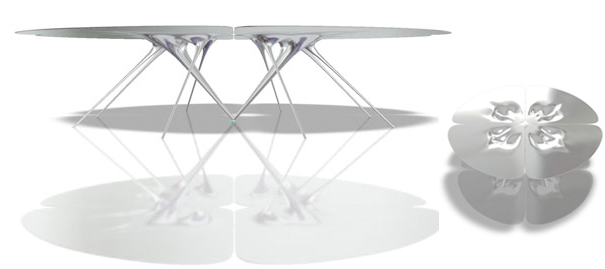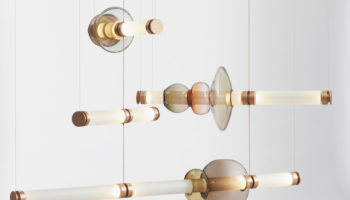At Design Miami: Ross Lovegrove’s Liquid Space
My earlier post regarding Design Miami-on Pieke Bergmans’ Crystal Virus-characterized both the artist and the venue as iconoclastic figures in design. The exhibit is in a class of its own because of its wholesale celebration of the intersection of art and design, and Bergmans’ work, particularly the melting glass vases, excels in its insistence on artful design as a nexus of process and confrontation. The trend of the iconoclast continues (as I’m sure it will from now until December 6) with another compelling encounter, between none other than Ross Lovegrove and Swarovski Crystal Palace.
Liquid Space. Designed by Ross Lovegrove. Manufactured by Swarovski Crystal Palace.
Everyone knows Lovegrove-last profiled in this forum during our week-long look at innovative lighting (Future of Fluorescents). Known to some as the very design nexus of technological innovation and natural forms, Lovegrove has been an immovable force for some twenty-five years, working in all facets of the industry, from the 80s mainstays of Apple Computer and Sony Walkman, to projects for an impressive diversity of clients including Peugeot, Japan Airlines, and Moroso. As for Swarovski, this producer of loose crystal, crystal components, and “design-driven finished products,” has been synonymous with the finest in precision-cut crystal for nigh on 110 years. The company creates everything from crystal figurines (a great favorite of the 400,000 some members of the Swarovski Crystal Society), to jewelry and embellished fashion, to the prismatic components for jaw-dropping chandeliers and lighting installations. Oh, did I mention they have their own museum?

But enough gushing, the pertinent question is what ineffabilities arise when Lovegrove meets Swarovski. And the answer is ineffable indeed: Lovegrove’s Liquid Space, a featured installation of Swarovski’s display at Design Miami, has so much going on I’m not sure where to begin. An interactive installation that highlights the interplay between crystal, hyper-polished aluminum, and light, Liquid Space reminds me in turns of the oddly-illuminated anteroom at the conclusion of 2001: A Space Odyssey and some divine manifestation of Christ’s celebrated grail. The piece is constituted of two principal components: a chandelier in the very shape of Yeats’ “widening gyre,” constructed of intricately interlaced and LED-embedded Swarovski Crystal; and a quartet of Lovegrove’s Bioform quarter tables. Both pieces are breath-taking in their own right, but in concert the effect is otherworldly.
The kicker is the chandelier’s seamless automation (controlled via remote-I told you Lovegrove has a soft spot for technology), that not only allows the user to toggle between different color light, but also to vary the placement of the vortex’s terminus: “in its fully extended position it is suspended below the table surface, thus illuminating the subforms of the tables and the floor below … however it can also lift up and liberate the space above the tables.” In the fully extended mode, the chandelier casts a divine light indeed. With the subtle shadow of its silhouette beneath it, the bioform table appears to have stolen the show and miraculously become the source of the light that has taken the shape of a celestial silvery goblet, sketched in bold relief against the darkness of the firmament. This nifty inversion is certainly part of the point. In his skillful intertwining of shades of white and chrome-the prisms of the crystal and the mirror-polished surface of the tables-Lovegrove has unsettled our comfortable distinctions between source and illuminated object, and may also have very well convinced us that down has become up.




Leave a Reply